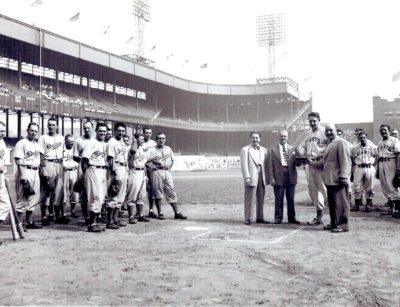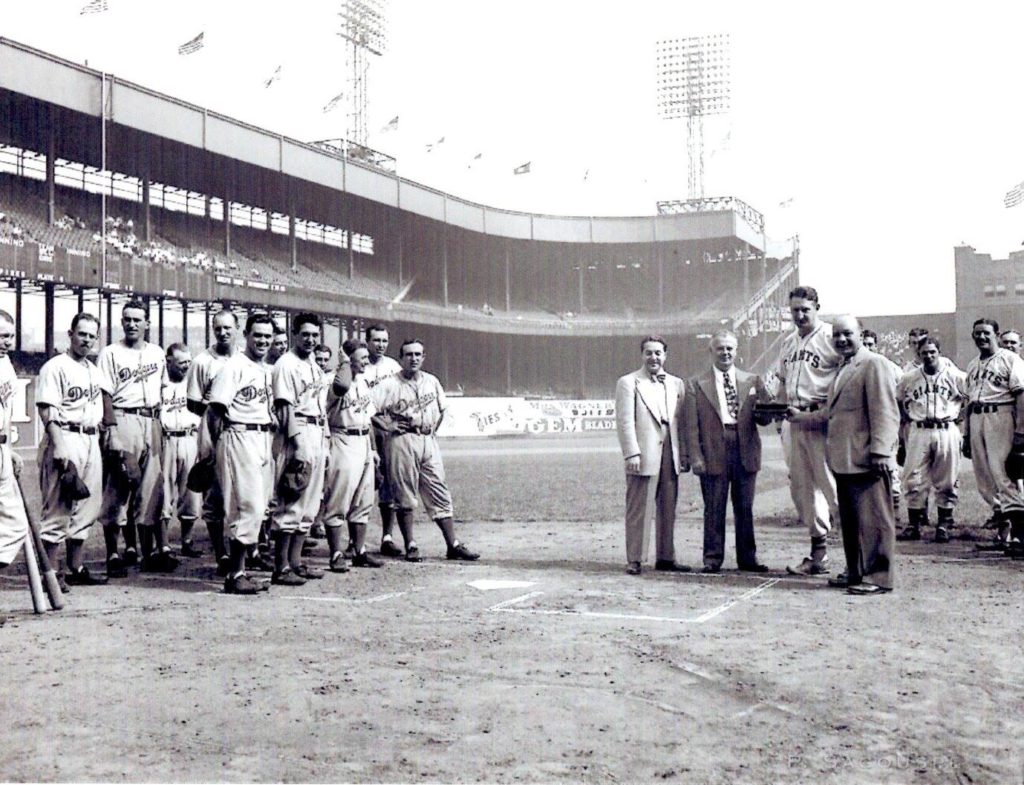Subscribe to Baseball History Comes Alive for automatic updates (sign-up block found in right side-bar)
As a Free Bonus for subscribing, you’ll get instant access to my two Special Reports: Memorable World Series Moments and Gary’s Handy Dandy World Series Reference Guide!
Ernie Lombardi Photo Gallery
Click on any image below to see photos in full size and to start Photo Gallery:

Should Ernie Lombardi Still Be Considered The “Goat” Of The 1939 World Series?
“Ernie Lombardi was probably the slowest man ever to play in the majors. And one of the most savage line-drive hitters ever as well.” –Edward Thoma, “Baseball Outsider”
As we all know postseason errors can become magnified and can even overshadow the career of the fine ballplayer. Just think about the late Bill Buckner.
The Ernie Lombardi “Snooze” from the 1939 World Series certainly falls into this category; but was it fair to call Ernie, one of the most underappreciated greats in baseball history, a “goat?” Maybe “scapegoat” is a better term…
The featured photo above is from “Ernie Lombardi Day.” I selected it to show what a physical giant of a man Ernie Lombardi was (he was listed at 6’3″, 230 lbs). I’m not
sure of the date, but from looking at other players I can identify in the photo, it appears to be between 1943 and 1945, part of his years with the Giants.
The 1939 World Series was between the Reds and the Yankees. The 1939 Yankees were considered one of the best teams ever. After three games, the Yankees led the series three games to none. The fourth game, played at Crosley Field, was tied 4-4 after nine and the game went into extra innings.
Frank Crosetti walked to start the tenth. After a sacrifice bunt, the Yankees’ burly right fielder, Charlie “King Kong” Keller grounded to shortstop Billy Myers, who booted it for an error, putting runners on first and third. The always dangerous Joe DiMaggio then strolled to the plate. What followed was one of the most chaotic plays in World Series history.
DiMaggio singled to right driving in Crosetti from third. Reds’ outfielder Ival Goodman fumbled the ball and hurried a throw to relay man Frank McCormick. Keller hustled around the bases beating the throw home and barreled into catcher Ernie Lombardi, hitting Ernie in the groin and knocking him to the ground.
Ernie was in pain and momentarily dazed. DiMaggio, immediately sizing up the situation, raced around the bases and scored while the ball was just a few feet away from the immobile Lombardi. Three runs had scored on a single! The New York press had a field day with the play and immortalized it as “Lombardi’s Big Snooze,” and that’s how it’s remembered in baseball lore even to this day.
According to baseball historian Bill James “Lombardi was the Bill Buckner of the 1930s, even more innocent than Buckner, and Buckner has plenty of people who should be holding up their hands to share his disgrace. Lombardi’s selection as the Series goat was absurd. The Yankees were already ahead three games to none and that DiMaggio’s run merely made the final score 7-4.”
Surely Ernie Lombardi deserves a better fate than to be remembered for this one unfortunate play which greatly tarnished the reputation of one of baseball’s greatest hitting catchers. The fact that Lombardi was so slow is a testament to just how great of a hitter he actually was. He hit over .300 for ten seasons and finished his 17-year major league career (1931-47), with a .306 average, 190 home runs, and 998 RBIs, despite infielders playing nearly on the outfield grass every time he came to the plate.
Only two other catchers in the Hall of Fame have a higher lifetime average than Lombardi. He won two batting titles (only catcher Joe Mauer has won more), and threw out an astonishing 47% of potential base stealers. He was the National League MVP for 1938, and was selected to eight All-Star teams. Ernie was a member of two pennant winners, and the 1940 World Series champion Reds.
Ernie Lombardi is included in Lawrence Ritter’s book “100 Greatest Baseball Players of All Time.” He was overlooked by the Hall of Fame until nine years after his death, and died a broken man in 1977, bitter over his snub by the Hall.
So let’s take a moment to remember a fine ballplayer who deserves a better fate than to be remembered for one unfortunate play in the World Series.
Gary Livacari
Check out my latest book, recently nominated for the SABR 2020 Lawrence Ritter Award: “Reflections on the 1919 Black Sox: Time to take Another Look,” now available on Amazon in e-book and paperback. All profits go to the Illinois Veterans Foundation: https://amzn.to/2uk6KBU

